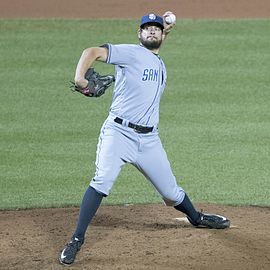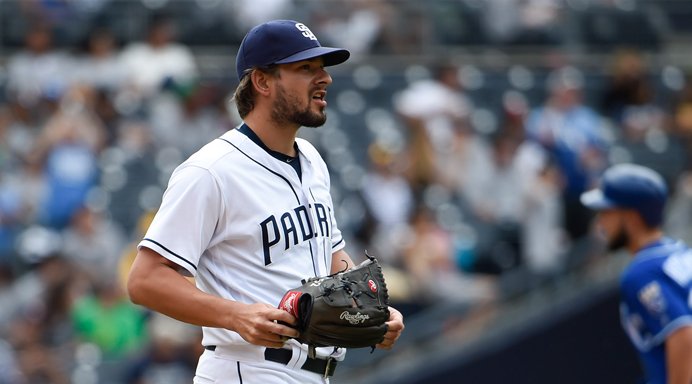PNO (Positives, Negatives, Outlook): Brad Hand

Credit: EVT News

In April of 2016, the San Diego Padres claimed Brad Hand from the Miami Marlins.
The Marlins had been using Hand mainly as a swingman in 2015 where he pitched to a 5.30 ERA and a 1.49 WHIP with a 6.46 K/9 and a 3.09 BB/9. With the Padres, Hand was immediately converted to a strict bullpen role and, with the help of a new found prowess for his slider, has become one of the most efficient left-handed pitchers in all of baseball.
Brad Hand’s 2016 season surprised many around baseball, but other teams began to take notice of the lefty during his all-star 2017 season. Hand was one of the most sought after relievers during the July trade deadline, and A.J. Preller and Co. made it clear they were open for business. The Hot Stove burned for days and days, but when the dust settled, Hand remained a Padre as teams didn’t want to meet Preller’s demands for a trade.
After the departure of Ryan Buchter (and his hilarious skit Between Two Bases) and Brandon Maurer, Hand was immediately given the closer role, and he thrived in it, converting 16 out of 21 saves on the season. If he isn’t traded this winter, expect for Hand to keep his job as the closer in 2018.
With the help of a lethal slider and an increased strikeout rate, Brad Hand became the Padres’ most reliable bullpen arm and a valuable trade candidate.
Here is a PNO (Positives, Negatives, Outlook) on him.
Positives
Increased use of Slider
Brad Hand’s success has come largely due to a slider that has become one of the best in baseball and one that helped him throw a 1-2-3 inning in Miami for the 2017 MLB All-Star Game. Hand’s increased slider usage led to him having a career year in nearly every category, carrying a 2.16 ERA and a 0.93 WHIP and leaving opposing batters with a .190 batting average against him. So what makes the slider so special? It could be how Hand holds it, as he grips the ball much like a pitcher would grip a two-seam fastball. When a batter sees the ball out of the glove, he expects to see a 93-95 mph fastball. Instead, he gets a sweeping slider at 82 mph and the batter either swings straight through it, or makes weak contact and chops the ball into the dirt.
When the slider is working, his other pitches get a benefit too. Because opponents are so focused on his slider, Hand can easily set his opponents up for a pitch with more velocity. His fastball can be used to generate strikeouts, while his sinker is a big reason as to why Hand had a ground ball ratio of 46.3%. By mixing up his repertoire, Hand kept batters off-balance and forced them to guess on pitches, resulting in them hacking away at pitches that end up in the dirt or rolling a pitch right into a double play.

Hand began using his slider in 2015 and in fact first threw it as a Marlin against the Padres, where he struck out Alexi Amarista. Hand only threw his slider 8.3 percent of the time as a Marlin, however he was still tinkering with the pitch and didn’t know how to harness it correctly. 2016 saw a big bump in usage of the pitch, as he threw his slider for 30.3 percent of his pitches, a 22 percent increase. He would increase it again in 2017, this time for 44.7 percent of his pitches (as well as a 14.4 percent increase). This increase has led other MLB teams to notice this left-handed dynamo from San Diego and his Andrew Miller-esque slider, which has turned him into one of the best left-handed relievers in baseball.
Improved Command and Strikeouts
An improved command of his pitches also helped Hand during his breakout season. His BB/9 rate was at a career low 2.27%, while his K/9 ratio also sat pretty at 11.80%. Hand also had a K% of 33.4 percent, while his BB% was at 6.4 percent. When comparing to other relievers with a minimum of 60 innings pitched, Hand ranked 11th overall in K%, 20th in BB%, 12th in K/9, and 20th in BB/9, very good numbers considering he only became a closer for the second half of the season.
Hand was also excellent with his walks. He only walked 20 batters in 79.1 innings of work while striking out 104. Only three other pitchers (Craig Kimbrel, Corey Knebel, and Kenley Jansen) had more strikeouts than Hand, with Knebel having 20 more walks than Hand. Brad Hand was also good at getting ahead of the count, with Fangraphs reporting Hand having a F-Strike% of 57.6 percent and a swinging strike rate of 13.3 percent. These numbers, combined with the pinpoint control Hand had shown throughout his 2017 season and a deadly slider, made him an effective option for manager Andy Green to utilize in the ninth inning.
Negative
Increased HR/9
Hand has a small chink in his armor, and it comes with his HR/9 ratio. While Hand only surrendered nine home runs on the year, five of those home runs came after July 24, when he became the closer. In fact, Hand blew two save opportunities because of the long ball (although the Padres were able to recover from one of these and give Hand a win).

His HR/9 ratio went up from .81 in 2016 to 1.02 in 2017, while his HR/FB rate was at 15%, the highest it has been in his career. Closers are supposed to be shut down anchors for their bullpen and can be relied on to quickly finish up a game, and can rarely give up home runs, or really any runs at all, giving Hand one, albeit small, weakness that could be exploited.
He may not be here much longer
Quality left-handed pitching is more valuable to Major League bullpens than buried treasure is to pirates. Hand was one of the most talked about commodities on the July Hot Stove, and Preller made sure that everyone knew he was available. Teams lined up to start negotiations for the lefty and the offers flew well into the final minutes of the trade deadline. Interested teams included the Yankees, Nationals, Dodgers, Astros, and even the Rays. However, teams cringed at the high asking price that Preller tagged on Hand, with the Nationals refusing to trade Carter Kieboom, the Astros not budging on six of their top prospects, and the Dodgers reluctant to include Alex Verdugo among a package of prospects. Without a deal he found satisfactory, Preller decide to keep his valuable trade piece and wait for his market to develop more in the offseason.
Since the trade deadline, it is safe to say that teams will be even more interested in Hand. Two of the top suitors could very well be the teams playing in the World Series, as both the Astros and Dodgers have suffered from some form of bullpen collapse, and with each team losing relievers to free agency, they’ll be in the market for a reliever. If Preller decides that he has a good package of prospects to acquire, you can be sure that Hand will be trading in his Padres jersey and finding a new home in a new town.
Outlook
2017 was the year that Brad Hand became one of the most talked about left-handed pitcher in all of baseball. After the trade of Brandon Maurer and Ryan Buchter, he stepped up to the closer position and thrived in it. His improved slider led to him collecting more strikeouts and issuing fewer walks than he had never achieved before in his career. However, he became extremely valuable to many playoff teams who wanted a quality lefty in their bullpen. Hand will be one of the most discussed relievers on the Hot Stove, and expect A.J. Preller to land at least two or three solid prospects for him if he ends up pulling the trigger on a trade. If Hand makes it to spring training, expect for him to appear as the closer and fool hitters once again with his wipeout slider.
I am currently attending San Diego State University while working on achieving a major in journalism. At SDSU, I write for The Daily Aztec while also hosting the sports radio show “Picked Off”, for KCR Radio. A loyal fan of San Diego sports, I hope to bring content that you will enjoy reading.